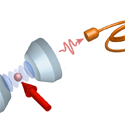Linked in
Networks provide an essential tool for many communication and computational tasks by connecting different regions of space to allow remote systems to talk to one another. In a quantum network, a link represents shared entanglement between remote systems. Establishing such a link involves the creation, distribution, storage, and retrieval of entanglement.
Writing in Physical Review Letters, Matthias Lettner and colleagues from the Max Planck Institute for Quantum Optics in Garching, Germany, report they are able to create such a link with a notably high fidelity of 95%. (Fidelity characterizes the reproducibility of preparing a quantum state.) They entangle two systems that sit in different laboratories located 13 meters apart. In one laboratory, they send a laser pulse onto a single Rubidium atom inside an optical cavity to create a photon that is entangled with the atom. The photon is allowed to depart the cavity to travel through 30 meters of optical fiber to another laboratory. There, a Bose-Einstein condensate (BEC) of Rubidium atoms captures the photon and stores it in the multi-atom wave function, creating an entangled state between the single atom and the atomic ensemble. Two final steps map the atom-BEC entanglement onto photon-photon entanglement: retrieving the stored photon from the BEC and, meanwhile, producing a second photon from the single atom.
This hybrid system, which demonstrates the creation, distribution, storage, and retrieval of entanglement across remote locations, is an essential link within, and a step towards, a real-world quantum network. – Sonja Grondalski





